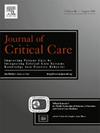入院前服用丁丙诺啡/纳洛酮的机械通气患者阿片类药物需求评估。
IF 2.9
3区 医学
Q2 CRITICAL CARE MEDICINE
引用次数: 0
摘要
背景:基于物质使用史(包括丁丙诺啡/纳洛酮使用)的阿片类药物需求量化数据有限,机械通气患者的最佳疼痛管理仍然未知。目的:比较重症监护病房(ICU)机械通气成人入院前服用丁丙诺啡/纳洛酮与未服用丁丙诺啡/纳洛酮的阿片类药物需求。方法:这项多中心、回顾性研究纳入了在医学ICU住院并机械通气至少12小时的成年人。主要终点是从插管到拔管或72小时的平均每小时阿片类药物率(芬太尼当量[FE], μg FE/h)。次要终点包括镇静需求、疼痛时间和镇静深度评分在目标范围内。为了调整混杂因素,采用负二项模型。结果:176例患者中47例服用丁丙诺啡/纳洛酮,69例opioid-naïve, 60例阿片类药物耐受。丁丙诺啡/纳洛酮组的平均小时阿片类药物率(40.8±37.1 μg FE/h)和opioid-naïve组(31.7±32.5 μg FE/h, p = 0.17)与阿片类药物耐受组(51±46 μg FE/h, p = 0.22)无显著差异。多变量回归显示丁丙诺啡/纳洛酮和opioid-naïve患者的小时率相似,但阿片类药物耐受患者的小时率高出50%(估计比率为1.5,95% CI[1.01, 2.23])。在进球时疼痛得分的时间是相似的。丁丙诺啡/纳洛酮与opioid-naïve患者镇静时间得分相似,但低于阿片类药物耐受患者。结论:入院前服用丁丙诺啡/纳洛酮机械通气至少12小时的患者阿片类药物需求与opioid-naïve患者相似,低于阿片类药物耐受患者。本文章由计算机程序翻译,如有差异,请以英文原文为准。
Evaluation of opioid requirements in mechanically ventilated patients taking buprenorphine/naloxone prior to admission
Background
With limited data quantifying opioid requirements based on substance use history, including buprenorphine/naloxone use, optimal pain management for mechanically ventilated patients remains unknown.
Objective
To compare opioid requirements in mechanically ventilated adults admitted to the intensive care unit (ICU) taking buprenorphine/naloxone prior to admission compared to those who do not.
Methods
This multicenter, retrospective study included adults admitted to a medical ICU and mechanically ventilated for at least 12 h. The primary endpoint was mean hourly opioid rate (fentanyl equivalents [FE], μg FE/h) from intubation until extubation or up to 72 h. Secondary endpoints included sedative requirements and time with pain and depth of sedation scores within goal. To adjust for confounders, a negative binomial model was performed.
Results
Of 176 patients, 47 took buprenorphine/naloxone, 69 were opioid-naïve, and 60 were opioid-tolerant. There was no difference in mean hourly opioid rate between buprenorphine/naloxone (40.8 ± 37.1 μg FE/h) and opioid-naïve (31.7 ± 32.5 μg FE/h; p = 0.17) and opioid-tolerant patients (51 ± 46 μg FE/h; p = 0.22). Multivariable regression demonstrated similar hourly rates in buprenorphine/naloxone and opioid-naïve patients, but opioid-tolerant patients had 50 % higher rates (estimated rate ratio 1.5, 95 % CI [1.01, 2.23]). Time spent with pain scores at goal was similar. Time spent with sedation scores at goal was similar between buprenorphine/naloxone and opioid-naïve patients, but was lower than opioid-tolerant patients.
Conclusion
Patients taking buprenorphine/naloxone prior to admission who are mechanically ventilated for at least 12 h may have opioid requirements similar to opioid-naïve patients and lower than opioid-tolerant patients.
求助全文
通过发布文献求助,成功后即可免费获取论文全文。
去求助
来源期刊

Journal of critical care
医学-危重病医学
CiteScore
8.60
自引率
2.70%
发文量
237
审稿时长
23 days
期刊介绍:
The Journal of Critical Care, the official publication of the World Federation of Societies of Intensive and Critical Care Medicine (WFSICCM), is a leading international, peer-reviewed journal providing original research, review articles, tutorials, and invited articles for physicians and allied health professionals involved in treating the critically ill. The Journal aims to improve patient care by furthering understanding of health systems research and its integration into clinical practice.
The Journal will include articles which discuss:
All aspects of health services research in critical care
System based practice in anesthesiology, perioperative and critical care medicine
The interface between anesthesiology, critical care medicine and pain
Integrating intraoperative management in preparation for postoperative critical care management and recovery
Optimizing patient management, i.e., exploring the interface between evidence-based principles or clinical insight into management and care of complex patients
The team approach in the OR and ICU
System-based research
Medical ethics
Technology in medicine
Seminars discussing current, state of the art, and sometimes controversial topics in anesthesiology, critical care medicine, and professional education
Residency Education.
 求助内容:
求助内容: 应助结果提醒方式:
应助结果提醒方式:


